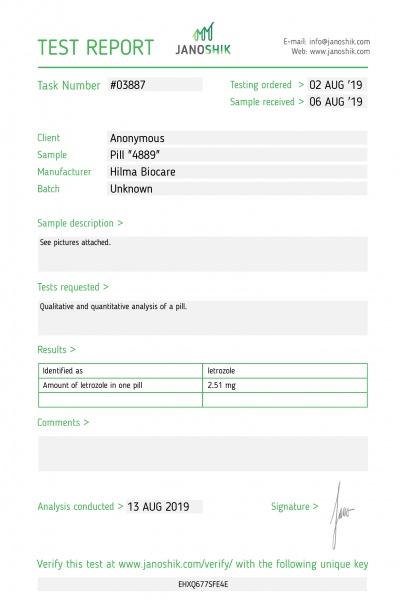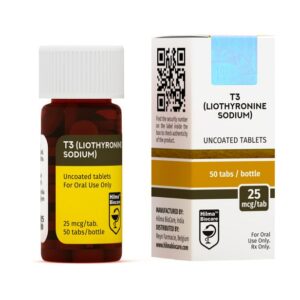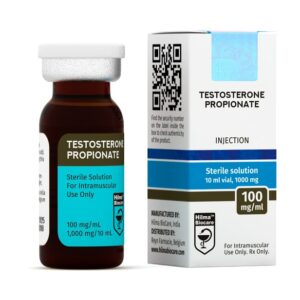Description
Letrozole 25
Strength: 2,5 mg
Molecular Formula: C17HNS
Molecular Weight: 285.31 g/mol
Active Ingredient: Letrozole
CAS number: 11280951-5
Dosage Form: Tablet
Route: Oral
Market Status: Prescription
Company: Hilma Biocare
DESCRIPTION
Letrozole is a nonsteroidal inhibitor of estrogen synthesis with antineoplastic activity. As a
third-generation aromatase inhibitor, Letrozole selectively and reversibly inhibits aromatase,
which may result in growth inhibition of estrogen- dependent breast cancer cells. Aromatase,
a cytochrome P-450 enzyme localized to the endoplasmic reticulum of the cell and found in
many tissues including those of the premenopausal ovary, liver, and breast, catalyzes the
aromatization of androstenedione and testosterone into estrone and estradiol, the final step
in estrogen biosynthesis. Pharmacodynamic effects The elimination of oestrogen-mediated
growth stimulation is a prerequisite for tumour response in cases where the growth of tumour
tissue depends on the presence of oestrogens and endocrine therapy is used. In
postmenopausal women, oestrogens are mainly derived from the action of the aromatase
enzyme, which converts adrenal androgens – primariy androstenedione and testosterone – to
oestrone and oestradiol. The suppression of oestrogen biosynthesis in peripheral tissues
and the cancer tissue itself can therefore be achieved by specifically inhibiting the aromatase
enzyme. In healthy postmenopausal women, Single doses of 0.1 mg, 0.5 mg, and 2.5 mg
Letrozole suppress serum oestrone and oestradiol by 75%-78% and 78% from baseline
respectively. Maximum suppression is achieved in 48-78 hours. In postmenopausal patients
with advanced breast cancer, daily doses of 0.1 mg to 5 mg suppressed plasma
concentration of oestradiol, oestrone, and oestrone sulphate by 75-95% from baseline in all
patients treated. With doses of 0.5 mg and higher, many values of oestrone and oestrone
sulphate were below the limit of detection in the assays, indicating that higher oestrogen
suppression is achieved with these doses. Oestrogen suppression was maintained
throughout treatment in all these patients. No changes were noted in plasmaedo
concentrations of androgens (androstenedione and testosterone)on among healthy
postmenopausal women after 0.1 mg, 0.5 mg, and 2.5 mg single doses of Letrozole or in
plasma concentrations of androstenedione among postmenopausal patients treated with
daily doses of 0.1 mg to 5 mg, indicating that the blockade of oestrogen biosynthesis does
not lead to accumulation of androgenic precursors. Plasma levels of LH and FSH are not
affected by Letrozole in patients, nor is thyroid function as evaluated by TSH, T4, and T3
uptake tests.
INDICATION
For the extended adjuvant treatment of early breast cancer in postmenopausal women who
have received 5 years of adjuvant Tamoxifen therapy. Also for first-line treatment of
postmenopausal women with homone receptor positive or hormone receptor unknown
locally advanced or metastatic breast cancer. Also indicated for the treatment of advanced
breast cancer in postmenopausal women with disease progression following antiestrogen
therapy.
ADMINISTRATION
Posology In patients with advanced or metastatic breast cancer, treatment with Letrozole
should continue until tumour progression is evident. In the adjuvant and extended adjuvant
setting, treatment with Letrozole should continue for 5 years or until tumour relapse occurs,
whichever is first. In the adjuvant setting a sequential treatment schedule (Letrozole 2 years
followed by Tamoxifen 3 years).gonaM In the neoadjuvant setting, treatment with Letrozole
could be continued for 4 to 8 months in order to establish optimal tumour reduction. If the
response is not adequate, treatment with Letrozole should be discontinued and surgery
scheduled and/or further treatment options discussed with the patient. Letrozole is not
recommended for use in children and adolescents. The safety and efficacy of Letrozole in
children and adolescents aged up to 17 years have not been established, Limited data are
available and no recommendation on a posology can be made.
CONTRAINDICATIONS
• Hypersensitivity to the active e substance or to any of the excipients
• Premenopausal endocrine status
• Pregnancy Breast-feeding
WARNINGS AND PRECAUTIONS FOR USE
Renal impairment No dosage adjustment of Letrozole is required for patients with renal
insufficiency with creatinine clearance> 10 ml/min, Insufficient data are available in cases of
renal insufficiency with creatinine clearance lower than 10 ml/min. Hepatic impairment No
dose adjustment of Letrozole is required for patients with mild to moderate hepatic
insufficiency (Child- Pugh A or B). Insufficient data are available for patients with severe
hepatic impairment. Patients with severe hepatic impairment (Child-Pugh C) require close
supervision. Menopausal status In patients whose menopausal status is unclear, luteinising
hormone (LH), follicle-stimulating hormone (FSH) and/or oestradiol levels should be
measured before initiating treatment with Letrozole. Only women of postmenopausal
endocrine status should receive Letrozole. Bone effects Letrozole is a potent
oestrogen-lowering agent. Women with a history of osteoporosis and/or fractures, or who are
at increased risk of osteoporosis, should have their bone mineral density formally assessed
prior to the commencement of adjuvant and extended adjuvant treatment and monitored
during and following treatment with Letrozole. Treatment or prophylaxis for osteoporosis
should be initiated as appropriate and carefully monitored. In the adjuvant setting a
sequential treatment schedule (Letrozole 2 years followed by Tamoxifen 3 years) could also
be considered depending on the patient’s safety profile. Other warnings Co-administration of
Letrozole with Tamoxifen, other anti-oestrogens or oestrogen-containing therapies should be
avoided as these substances may diminish the pharmacological action of Letrozole, if
overwise is not directed by physician. As the tablets contain lactose, Letrozole is not
recommended for patients with rare hereditary problems of galactose intolerance, of severe
lactase deficiency or of glucose-galactose malabsorption. Effects on ability to drive and use
machines Letrozole has minor influence on the ability to drive and use machines. Since
fatigue and dizziness have been observed with the use of Letrozole and somnolence has
been reported uncommonly, caution is advised when driving or using machines.
ADVERSE REACTIONS
Commonly reported side effects of letrozole include: bone fracture, arthralgia, edema,
dizziness, fatigue, hypercholesterolemia, osteoporosis, and flushing. Other side effects
include: myalgia. Less common side effects: bone fracture, breast pain, chest pain, chills,
fever, or flu-like symptoms, mental depression, swelling of the feet or lower legs. Possible
cardiological adverse events for Letrozole and Tamoxifen, respectively let median treatment
duration of 60 months plus 30 days): angina requiring surgery (in 1.0% cases); cardiac
failure (1.1% ); hypertension (5.6% %); cerebrovascular accident/transient ischaemic attack
(2.1%). Check with your doctor if any side effects occur while taking Letrozole.
DRUG INTERACTION
Metabolism of Letrozole is partly mediated via CYP2A6 and CYP3A4. Cimetidine, a weak,
non specific inhibitor of CYP450 enzymes, did not affect the plasma concentrations of
Letrozole. The effect of potent CYP450 inhibitors is unknown. There is no clinical experience
to date on the use of Letrozole in combination with oestrogens or other anticancer agents,
other than Tamoxifen. Tamoxifen, other anti-oestrogens or oestrogen-containing therapies
may diminish the pharmacological action of Letrozole. In addition, co-administration of
Tamoxifen with Letrozole has been shown to substantially decrease plasma concentrations
of Letrozole. Co- administration of Letrozole with Tamoxifen, other anti-oestrogens or
oestrogens should be avoided, unless otherwise specified by the doctor. In vitro, Letrozole
inhibits the cytochrome P450 isoenzymes 2A6 and, moderately, 2C19, but the clinical
relevance is unknown.
DOSAGE
The recommended dose of Letrozole tablets is one 2.5 mg tablet administered once a day,
without regard to meals. No dose adjustment is required for elderly patients. Half life of
Letrozole is 2 days.
STORAGE
Store in a cool dry place between 15-25°C. Protect from light.





